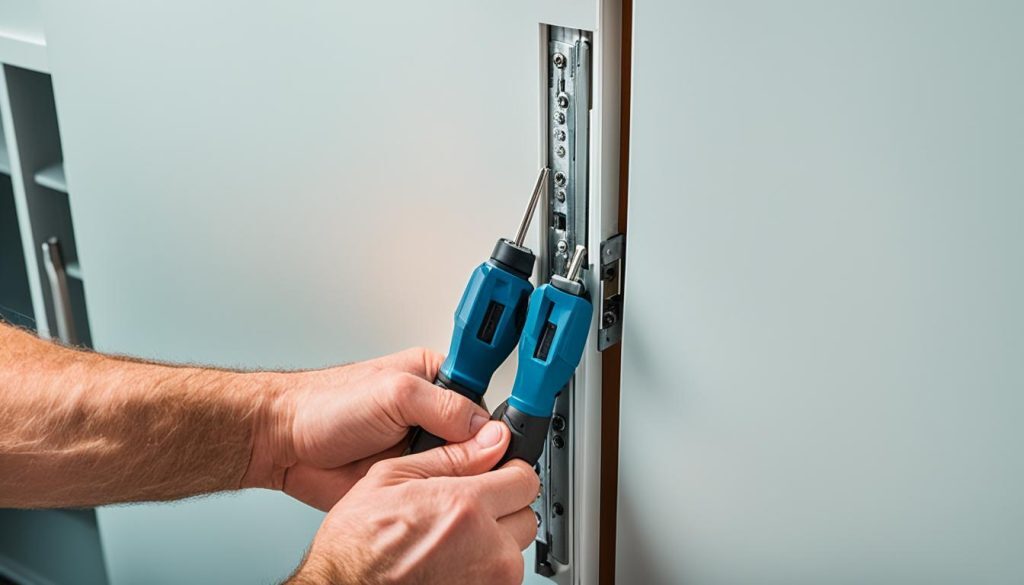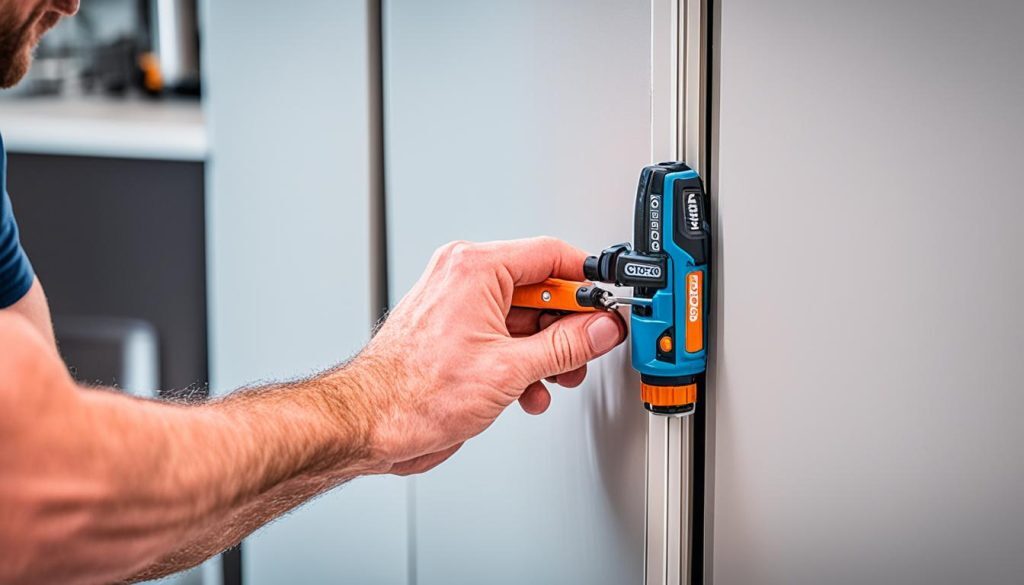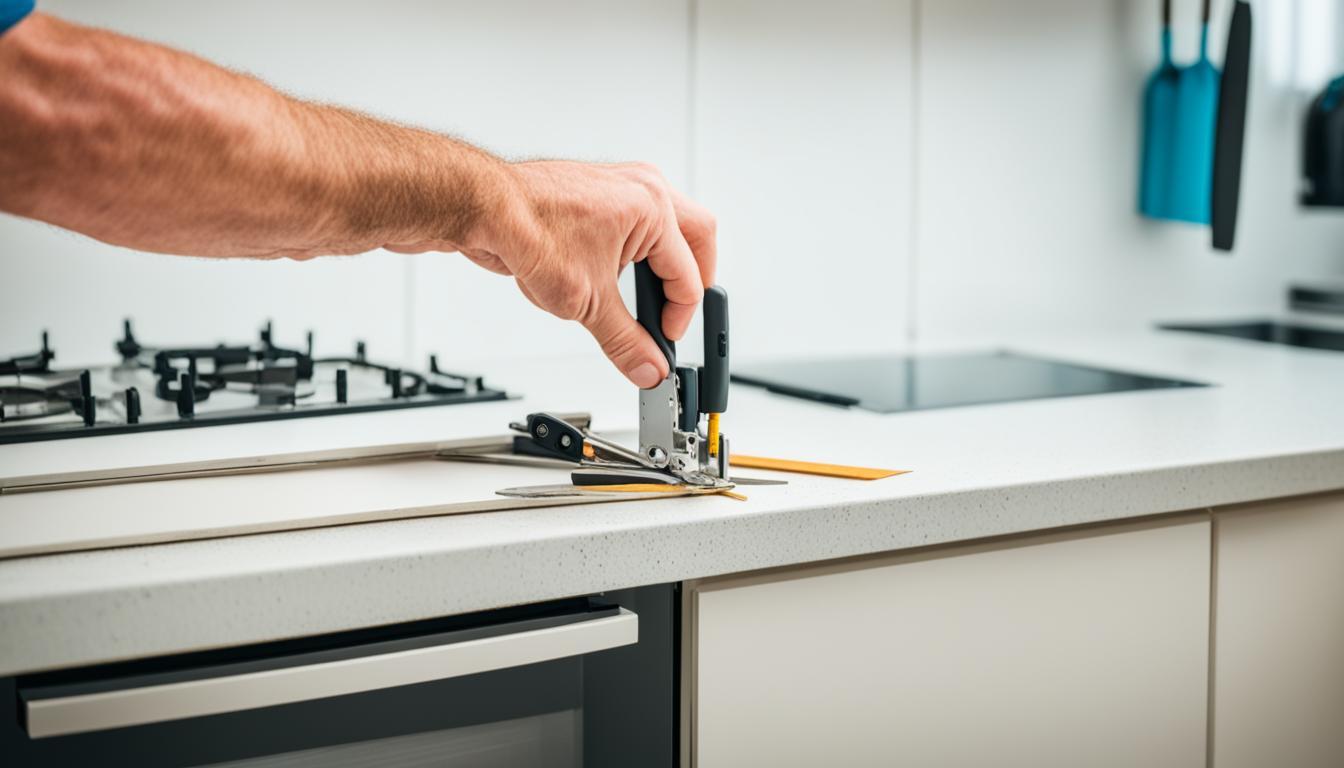Did you know that misaligned cabinet doors can account for more than 80% of kitchen malfunctions? That’s right! It’s a common problem that many homeowners face, but the good news is that you can easily fix it by adjusting your cabinet hinges. In this article, I will guide you through the step-by-step process of adjusting kitchen cabinet hinges, so you can say goodbye to those pesky doors that won’t close properly.
Adjusting cabinet hinges is a cost-effective and straightforward solution that can save you from the hassle of replacing your entire cabinets. By making a few simple adjustments, you can restore proper door alignment and functionality. So, grab your screwdriver and let’s get started!
Key Takeaways:
- Adjusting cabinet hinges is a simple and cost-effective solution for fixing cabinet doors that won’t close properly.
- Most cabinets today have fully adjustable hinges with three directional adjustments: up and down, side to side, and in and out.
- Vertical adjustment involves tightening the screws and using oval holes on the hinge to adjust the door height.
- Horizontal adjustment can be done by using the side-to-side adjustment feature on the hinges.
- Depth adjustment is used to address gaps or misalignment between the door and the cabinet box.
Types of Cabinet Hinges and Their Adjustments
When it comes to adjusting kitchen cabinet hinges, it’s important to understand the different types of hinges and their adjustment capabilities. Most cabinets nowadays come with fully adjustable hinges that offer three directional adjustments: up and down, side to side, and in and out. These adjustments can be made using the screws that mount the hinges to the cabinet.
Some hinges may also have mechanisms for side-to-side and depth adjustments, allowing for fine-tuning to fix crooked cabinet doors. However, it’s crucial to note that the specific adjustments may vary depending on the hinge type and cabinet design.
Before starting the process of adjusting cabinet hinges, ensure that the mounting screws are secure to provide a stable foundation for the adjustments.
Now, let’s take a closer look at the different adjustments you can make to your cabinet hinges to fix crooked cabinet doors.
Vertical Adjustment of Cabinet Doors
If your cabinet doors are misaligned vertically, there are simple steps you can follow to adjust them and restore their functionality. Start by checking the screws that mount the hinges to the cabinet. It’s important to ensure these screws are tight and secure, as loose screws can contribute to door misalignment.

If the doors are still too high or low, look for screws on the hinges that allow you to adjust the door up and down. These screws are characterized by oval holes on the cabinet hinge, which provide some play between the hinge and the screws.
To adjust the vertical position of the cabinet doors, follow these steps:
- Loosen the mounting screws slightly using a screwdriver.
- Adjust the door to the desired height by moving it up or down.
- Once the door is at the correct height, retighten the mounting screws.
- Repeat this process for each hinge that requires adjustment.
By following these steps, you can easily adjust the vertical alignment of your cabinet doors and ensure they close properly. Take your time and make small adjustments, checking the door position after each tweak. This will allow you to fine-tune the alignment and achieve the desired fit.
| Hinge | Adjustment Method |
|---|---|
| European-style concealed hinge | Use screws with oval holes for vertical adjustment |
| Surface-mounted hinges | Vertical alignment may not be adjustable |
| Pivot hinges | Vertical adjustment is possible with mounting screws |
Horizontal Adjustment of Cabinet Doors
When it comes to improving the alignment of your cabinet doors, the horizontal adjustment feature on the hinges is a valuable tool. By making simple adjustments, you can fix crooked doors and achieve a seamless look in your kitchen.
To begin the horizontal adjustment process, you’ll need to locate the side-to-side adjustment screw on each hinge. Depending on the degree of correction needed, you can adjust one or both hinges on each door.
If you notice that the door is tilting down to the right, follow these steps:
- Identify the top hinge and locate the side-to-side adjustment screw.
- Using a screwdriver, turn the side-to-side screw on the top hinge clockwise. This will pull the top of the door closer to the side of the cabinet box.
- If further adjustment is necessary, locate the side-to-side adjustment screw on the bottom hinge.
- Turn the side-to-side screw on the bottom hinge clockwise to move the bottom of the door to the right.
It’s important to note that the adjustment process may require some fine-tuning to ensure proper alignment. Take your time and make small adjustments as needed until the door sits perfectly in line with the cabinet box.
Remember, adjusting the horizontal alignment of your cabinet doors is just one step in the process of achieving a flawless look. Be sure to also address vertical and depth adjustments, if necessary, to ensure all aspects of your cabinet doors are properly aligned.
Next, let’s explore the depth adjustment of cabinet doors.
Side-to-Side Adjustment Guidelines
| Action | Adjustment Direction |
|---|---|
| Turn side-to-side screw on top hinge | Clockwise (to the right) |
| Turn side-to-side screw on bottom hinge | Clockwise (to the right) |

Depth Adjustment of Cabinet Doors
When it comes to fixing cabinet hinges and adjusting kitchen cabinet hinges, one important adjustment to consider is the depth adjustment. This adjustment allows you to move the cabinet door in and out in relation to the cabinet box, addressing any gaps or misalignment between the door and the box.
To make the depth adjustment, follow these steps:
- Locate the depth adjustment screw on the hinge.
- Using a screwdriver, turn the depth adjustment screw clockwise to bring the door closer to the cabinet box, or counterclockwise to move it away.
- Push the door inward or pull it outward to the desired location.
- Once the door is properly aligned, tighten the screw to hold the door in place.
It’s important to check the door position and make necessary adjustments before tightening the screw to ensure proper alignment. By making the necessary depth adjustments, you can ensure that your cabinet doors meet the box properly and eliminate any gaps or misalignment.
| Benefits of Depth Adjustment | Challenges of Depth Adjustment |
|---|---|
| – Eliminates gaps between cabinet doors and the cabinet box | – Requires careful measurement and adjustment |
| – Improves the overall aesthetic of the cabinet | – Adjustments may need to be made periodically due to seasonal changes |
| – Ensures smooth and seamless operation of the cabinet doors | – May require professional assistance if the hinges are damaged beyond adjustment |
Additional Tips and Considerations
When it comes to adjusting cabinet hinges that won’t close, it’s important to remember a few additional tips and considerations. These tips will help you fine-tune your adjustments and ensure that your cabinet doors are functioning properly.
-
Make minor adjustments: When adjusting cabinet hinges, it’s best to make small and gradual adjustments. This allows you to fine-tune the alignment of the doors and avoid overcompensation.
-
Check the door position: After each adjustment, it’s essential to check the position of the door. Open and close the door to ensure that it is moving smoothly and closing properly. If needed, make further adjustments until the desired position is achieved.
-
Account for seasonal changes: Wood doors may slightly warp with seasonal changes in temperature and humidity. As a result, you may need to readjust your cabinet hinges periodically. Stay vigilant and make necessary adjustments to maintain optimal functioning.
-
Surface-mount hinges and gaps: If your cabinet doors have surface-mount hinges or if you notice gaps along the edges that show the frame, different adjustment techniques may be required. Look for specific instructions or consult a professional to ensure the correct adjustments are made.
-
Consider professional help or hinge replacement: If you have attempted multiple adjustments and your cabinet doors still won’t close properly, it may be time to consider seeking professional help or replacing the hinges. A professional can diagnose any underlying issues or suggest alternative solutions. Damaged hinges that are beyond adjustment may need to be replaced for optimal functionality.
Remember, adjusting your cabinet hinges is a practical DIY task that can save you time and money. By following these tips and leveraging your newfound knowledge, you’ll be able to fix cabinet doors that won’t close and restore functionality to your kitchen or other cabinets. Take the time to make the necessary adjustments, and enjoy the satisfaction of a smoothly operating cabinet system.
When to Replace Cabinet Doors
If you have exhausted all the adjustment techniques to fix your cabinet hinges and the doors still won’t close properly, it may be time to consider replacing them. While fixing cabinet hinges is usually a cost-effective solution, there are instances where replacement is the better option.
Replacing cabinet doors can provide a relatively easy fix compared to replacing the entire cabinet. By measuring the size and style of your existing doors, you can choose new ones that fit your desired aesthetic and seamlessly integrate into your kitchen or living space.
By replacing cabinet doors, you not only address the functionality issue but also have the opportunity to give your cabinets a fresh look. This can be a simple and effective way to transform the appearance of your space without the need for a major renovation.
